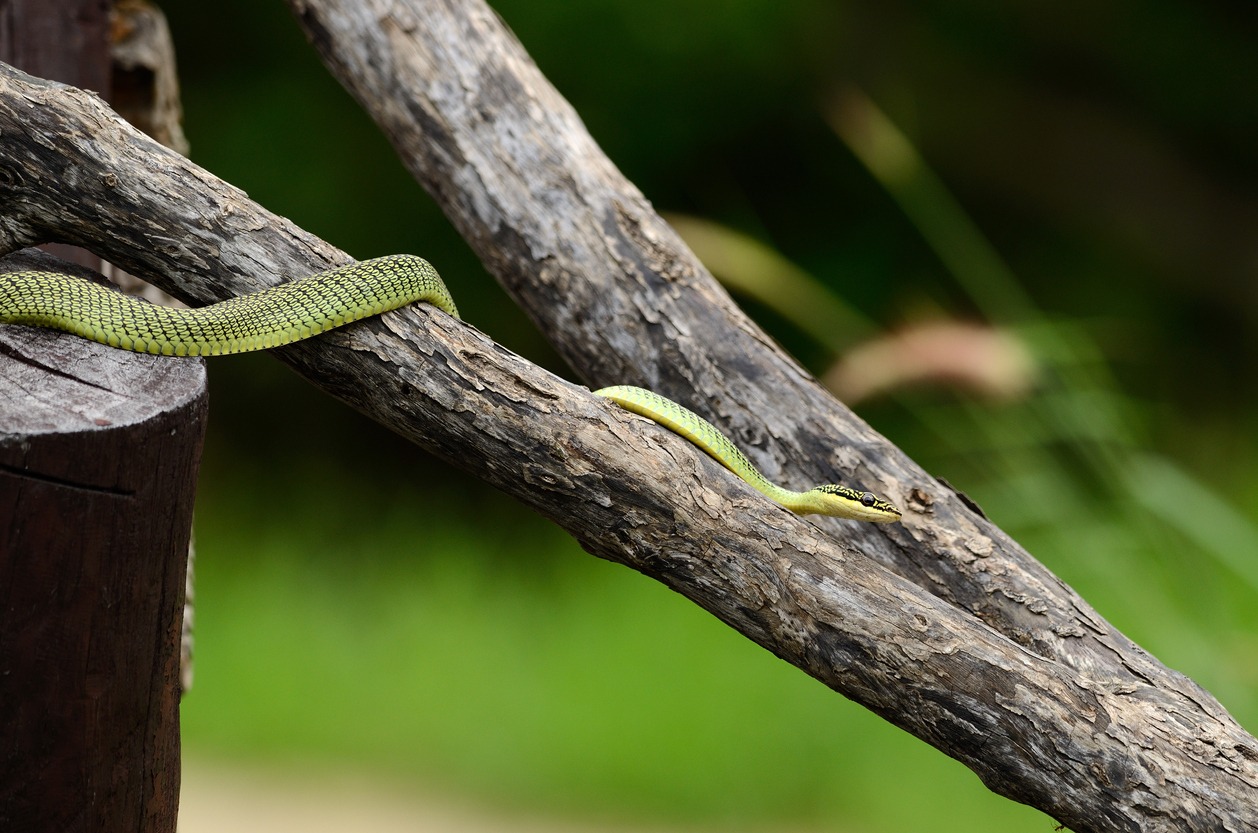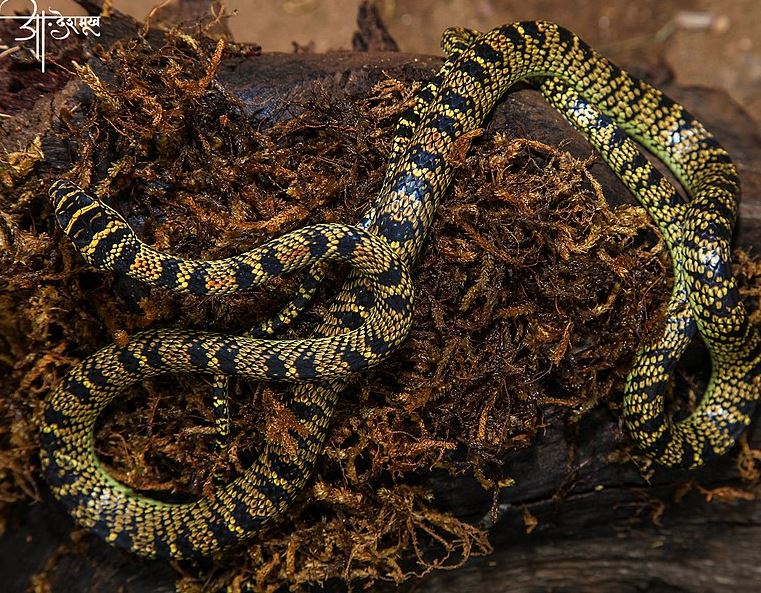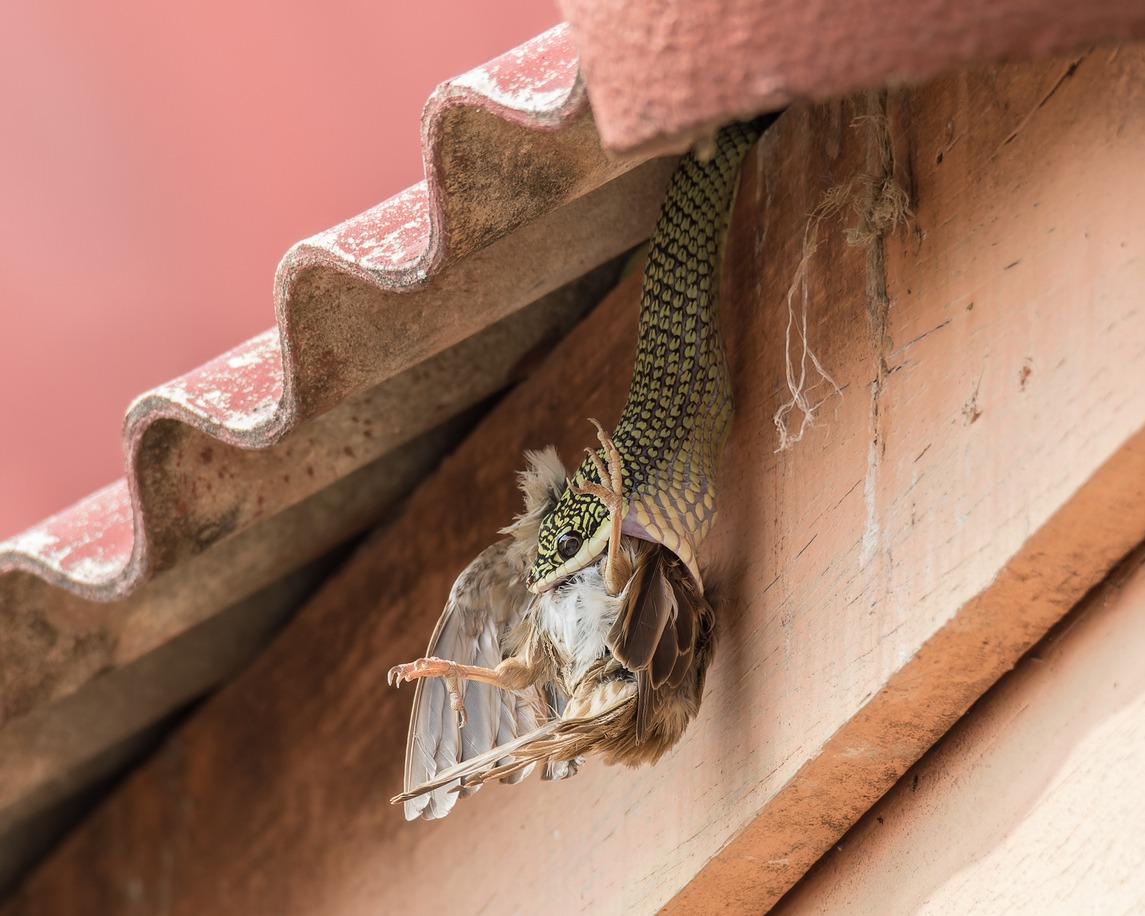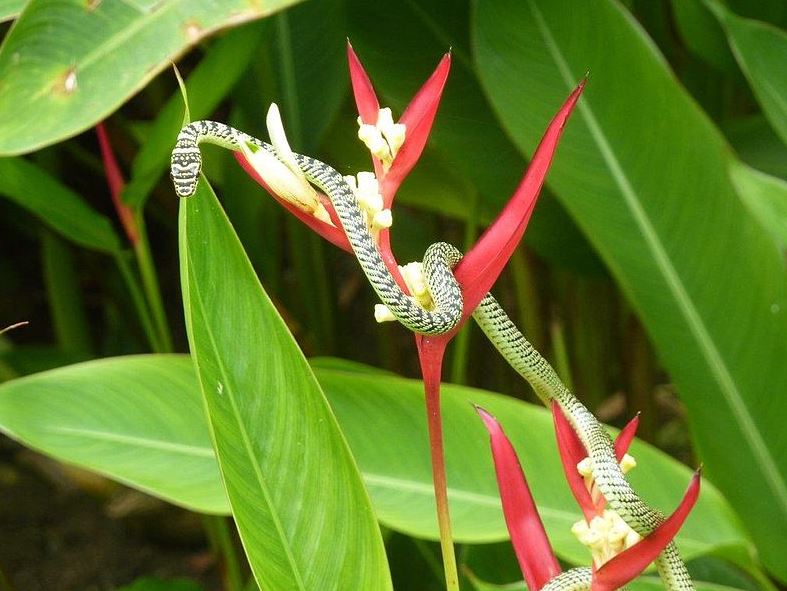Golden Tree Snakes are the snake equivalent of the roadrunner – they are thin, fast, and agile. They can climb bushes and trees faster than any other snake, striking lightning fast.
These snakes are very common in Thailand and are unquestionably among the top five snakes you will likely encounter in this country. You’ll see one to two a week on average, even if you don’t look for them. Because they are constantly snaking across the roads, your best chance of catching them is on the road if you can hop off your motorcycle or vehicle quickly enough.
So, can you keep a Golden Tree Snake as a pet in Thailand? Continue reading for answers.
Would Golden Tree Snakes Make an Excellent Pet?
The chrysopelea ornata (Golden Tree Snake) is a colubrid snake that you can find in Southeast and South Asia. It is rear-fanged and, like the other species in the Chrysopelea genus, is unique in that it can fly in a gliding motion. The snake’s striking appearance and gliding ability make it a favorite for captivity.
In the past few years, ornate flying snakes have become increasingly popular in the exotic pet trade, with many being exported from Vietnam and nearby countries. However, cases of captive breeding are extremely rare.
The snake’s striking and beautiful scales and its ability to glide between trees make it an excellent candidate for captivity. They are, however, better suited to their natural environment and should not be held captive.
Because of their difficulty adjusting to captivity and nervous temperament, they make poor captives for all except for the most experienced reptile keepers. Many imported specimens have high parasite loads, and the strain of captivity often results in premature death.
They thrive in their natural habitat of trees in forests and only reproduce in the wild. They are known to avoid mating in captivity.
Appearance
The Golden Tree Snake is typically green with black crosshatching and gold or yellow accents. The body is slender, but not as much as other tree snakes. The snake has a flattened head with a blunt nose, a constricted neck, and large, round pupils in its eyes.
This snake is distinguished by the lateral, pronounced, and sharp-keeled condition of the ventrals and the normal, not enlarged, vertebral row of scales. This snake can grow to be 11.5 to 130 cm long. Maturity occurs at approximately 1 m in length, with the tail accounting for approximately one-fourth of the overall length.
Chrysopelea ornata, also known as Ngoo kee-ow ly dok mak in Thailand, is lime green with black and green crosshatches. This snake’s head is rather flat, with an unusually blunt nose, a thin neck, and large eyes that can be red depending on its angle. When moving, it appears as a green snake.
Range of Geography
These snakes reside in India (North Bengal), Sri Lanka, Bangladesh, Myanmar, Western Malaysia, Thailand, Laos, Vietnam, Cambodia, Indonesia (Sumatra, Borneo, Java, Sulawesi), China (Hainan, Hong Kong, Yunnan), and the Philippines.
Behavior
The Golden Tree Snake is an arboreal and diurnal creature. While not as impressive as the paradise flying snake (C. paradisi), the snake’s gliding ability allows it to move from tree to tree with relative ease.
These snakes are excellent climbers, able to move across the thinnest of branches and straight-up trees with very few branches using rough bark edges. They are frequently seen moving in graceful curves up a coconut palm or up vertical rock faces, gripping the rather uneven surfaces using their scales.
They are fast-moving, nervous snakes that will try to flee if disturbed but will generally bite if handled. They are mildly venomous, but their venom is not dangerous to humans. Its purpose is to aid in the capture of fast-moving, arboreal prey.
C. ornata eats small arboreal prey such as bats, lizards, and small rodents. It may also consume insects and bird eggs. It is also reported to take snakes occasionally and avoid frogs, though frogs have also been reported to be eaten. The snake stalks or pursues its prey and catches it by the neck, squashed in its powerful jaws.
Human Habitats
The Golden Tree Snake is a pervasive snake that has successfully adapted to human environments. They are said to stay hidden in the thatch of the roofing material from within bungalows in Southern Thailand to prey on mice and geckos at night. In these areas, it is almost certain that a C. ornata can be found almost anywhere, possibly hiding under the roots of a tree, in the crown of a neighboring coconut palm, or curled up in a potted plant.
They have been observed dropping down from the crowns of coconut palms when pursuing and hunting fleeing prey. Many snakes are killed indiscriminately because locals mistakenly believe all snakes are venomous. The Golden Tree Snake is occasionally cooked for food.
Flight
C. ornata, like the other species in the genus, parachutes or glides. This is supposedly done to cover longer distances faster to catch prey, avoid predators, or move around in forests.
Flying snakes typically parachute from tree to tree, but they can also jump from tree to ground. They have been known to cross distances of up to 100 meters.
It accomplishes this by climbing to an elevated height, which it easily accomplishes thanks to its keeled abdominal scales, and then launching into mid-air. The snake inwardly contracts its ventral surface to create a U-shaped concave depression along its entire length, keeping the ventral scales’ outer edges rigid. This concave surface acts as a parachute, increasing air resistance and allowing it to glide forward using the thrust of its launch.
The snake pulsates through the air in a swimming-like movement. It holds the tail upwardly and achieves balance by twisting the tail sideways. This motion permits it to propel forward, resulting in a clumsy landing at the end of its flight.
Reproduction
Breeding habits are poorly understood. The snake is oviparous, laying six to 12 elongated eggs. In May and June, gravid females were obtained, as were hatchlings. Hatchlings are 114–152 mm (4–6 in) long, while the smallest gestid female measured 1,093 mm (3 ft 7 in).
Conservation Status
The Golden Tree Snake’s conservation status remains Least Concern. There are many of these mildly venomous snakes worldwide, particularly in Southeast Asian countries. They are, however, frequently killed in urban areas because of fear. They are also prevalent in the pet trade and often die during long journeys.
Journeying to Thailand to encounter Golden Tree Snakes? Read these backpacking tips that will help you stay safe in Thailand.




